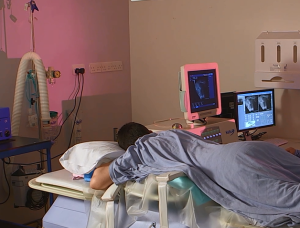Oxford-Technikos venture capital deal yields tenth Oxford University Innovation spin-out

15th April 2014
The 2006 deal in which London-based venture capital fund Technikos provided £12m for the University of Oxford’s Institute of Biomedical Engineering (IBME) in return for half of the University’s equity in new companies based on IBME intellectual property, has notched up its tenth spin-out company.
The IBME, part of the Department of Engineering Science, occupies 1700m2 of laboratories and sits at the heart of Oxford’s Medical Research Campus next to the Churchill Hospital. It was completed in 2008 and provides state-of-the-art laboratories for research and collaboration between engineers, biologists and clinicians. The Technikos deal contributed to building and equipment costs as well as providing funding for strategic staff appointments.
OxSonics, the most recent spin-out under the agreement, was set up through the University’s technology commercialisation company Oxford University Innovation in January 2014. It will use ultrasound technology and ultrasound-sensitive nanoparticles developed by an IBME research group headed by Professor Constantin Coussios to treat cancer and back pain.
In 2013, Run3D commenced operations providing runners with a 3D motion analysis service to analyse and correct gait problems. IBME Professors Lionel Tarassenko and Alison Noble respectively provided the inventive vision behind the Institute’s two 2012 spin-outs, OxeHealth (non-contact vital signs) and Intelligent Ultrasound (ultrasound image enhancement software).
At CN Bio Innovations, formerly Zyoxel, scientists provide next generation tissue and disease models which can fast track new drug therapies. The company was spun-out in 2009.
OrganOx, a 2008 spin-out, is aiming to increase the quality and supply of organs for transplantation.
OrganOx has completed a clinical study in the UK and is planning further studies in the US and Europe. The company is aiming to launch a CE marked device in Europe later in 2014.
Other spinouts include Oxford MESTAR (development of bio-medical technologies for the Chinese market), Oxyntix (nuclear fusion research), Fuel 3D (low cost hand-held 3D scanning) and Particle Therapeutics (drug delivery).
Professor Alison Noble, Director of the IBME said: “The deal between Technikos and the University has spearheaded a remarkably active period of IBME history that has enabled some of the most promising academic research ideas at the IBME to be successfully and quite quickly translated into commercially viable products. The Institute’s successes has played a key role in creating a culture of innovation, entrepreneurship and desire to have impact in our researchers and postgraduate students that in my view is unrivalled in the UK or possibly worldwide. None of this would have been possible without the support of the Technikos deal.”
Tom Hockaday, Managing Director of Oxford University Innovation, said: “Biomedical engineering research is a real strength at Oxford and the results so far from the deal between Technikos and the University have been outstanding. It has been an incredibly productive eight years working with Technikos and our colleagues at the IBME identifying promising projects of commercial value, assisting with early management and marketing, and steering these towards successful investment and incorporation.”
Stephen Brindle, a partner with Technikos, said: “It is a privilege to be able to assist the academics at the IBME commercialise their scientific research, and to support technology which we hope in the future will improve peoples’ lives”.
The Institute is focused on bio-medical image analysis, bio-medical signal processing, bio-medical ultrasonics, drug and vaccine delivery, fluid mechanics, orthopaedics bio-medical engineering and tissue engineering and bio-processing.
Press release sign up
